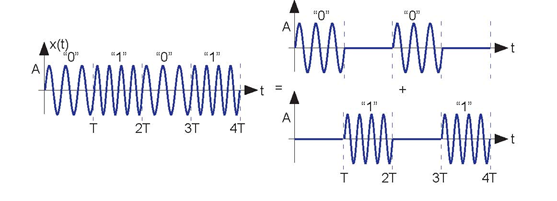In frequency-shift keying (FSK), the bit affects the frequency of a carrier sinusoid.

 (6.41)
(6.41)

The frequencies f0, f1 are usually harmonically related to the bit interval. In the depicted example,  and
and  As can be seen from the transmitted signal for our example bit stream (Figure 6.12), the transitions at bit interval boundaries are smoother than those of BPSK.
As can be seen from the transmitted signal for our example bit stream (Figure 6.12), the transitions at bit interval boundaries are smoother than those of BPSK.

This plot shows the FSK waveform for same bitstream used in the BPSK example (Figure 6.8).
To determine the bandwidth required by this signal set, we again consider the alternating bit stream. Think of it as two signals added together: The first comprised of the signal s0 (t), the zero signal, s0(t), zero, etc., and the second having the same structure but interleaved with the first and containing s1 (t) (Figure 6.13).

The depicted decomposition of the FSK-modulated alternating bit stream into its frequency components simplifies the calculation of its bandwidth.
Each component can be thought of as a fixed-frequency sinusoid multiplied by a square wave of period 2T that alternates
between one and zero. This baseband square wave has the same Fourier spectrum as our BPSK example, but with the addition of the constant term c0. This quantity's presence changes the number of
Fourier series terms required for the 90% bandwidth: Now we need only include the zero and first harmonics to achieve it. The bandwidth thus equals, with  If the two frequencies are harmonics of the bit-interval duration,
If the two frequencies are harmonics of the bit-interval duration,  and
and  with k1 > k0, the bandwidth equals
with k1 > k0, the bandwidth equals If the difference between harmonic numbers is 1,
then the FSK bandwidth is smaller than the BPSK bandwidth. If the difference is 2, the bandwidths are equal and larger differences produce a transmission bandwidth
larger than that resulting from using a BPSK signal set.
If the difference between harmonic numbers is 1,
then the FSK bandwidth is smaller than the BPSK bandwidth. If the difference is 2, the bandwidths are equal and larger differences produce a transmission bandwidth
larger than that resulting from using a BPSK signal set.
- 瀏覽次數:3924






